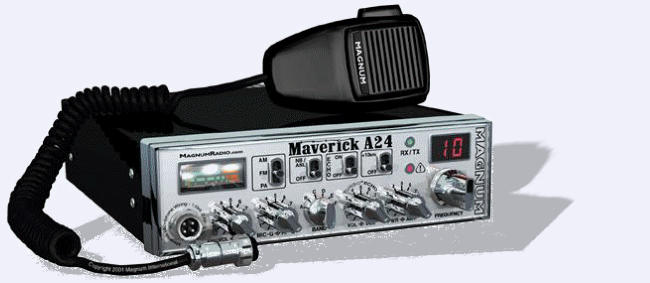Review: Magnum's New Maverick AM/FM 10 Meter Mobile

Last week the good folks at Magnum International sent a pre-production 10-meter mobile for evaluation.
Although the faceplate is obviously a prototype, the circuit boards look like regular production units. They
also assured me that this unit is electronically complete, as they will be produced.
This is an AM/FM 10 Meter radio with dual final output transistors. Out of the box I would expect it to be
setup as many of the other 10-meter radios are, 8-10 watt dead key and 25 watts modulated peak power.
The front panel on the radio is brushed aluminum with black lettering. I'm told that a second faceplate will
come with every A24 that is black with florescent light green lettering. This faceplate will replace the one
supplied on the radio. It's a matter of slipping the knobs off and pealing the old faceplate off. The faceplate
is a self adhesive backed unit, just peal the sheet off the back and put it in place and slipping the knobs
back on.
The Maverick A24 came with a Landmatic frequency counter hardwired, which provided a 6-digit frequency
readout that had a very fast response to channel changes. The production radio will have a connector in
the rear chassis to accept the galaxy and similar type 6-digit frequency counters. It’s unclear at this time
whether Magnum will offer their own counter due to the availability of the other plug-in counters already on
the market.
This radio is quite a departure from the CPU driven line of radios they now produce. It is a PLL type with
band selection very similar to the Galaxy, Connex, and General Lee radios. The band selector has 6-bands
of 40 channels giving it 240 channel positions and in addition it has a +10Khz switch adding 5 more
channels per band selection to catch the A-channel skips built into the channels selector switch that have
found their way into 10-meter radios. For those that aren’t aware of it, there are 5 radio control (RC)
channels in the lower half of the CB band. The RC channels are located between channels 3 and 4, 7 and
8, 11 and 12, 15 and 16, and 19 and 20, they are referred to as channels 3A, 7A, 11A, 15A, and 19A
respectively.
Although the CPU based radios offer more features, they are more complicated to use. A large sector of
radio operator’s don’t want a complex radio. In mobile operation, drivers and particularly truck drivers want
a straightforward radio to operate while driving. They’re looking for radios that are compatible with what’s
already out there in use. The most straightforward radios have band switches and no memory channels. It’s
much easier for them to go up or down a click on the band switch rather than press a band push button
switch multiple times to get where they’re going. This radio is aimed to compete with the best selling radios
on the market.
The test unit was sent via another CB shop. The modulation limiter was completely disabled by that shop.
On the bench the radio transmitter output was 10 watt dead key and with modulation peaks up to 40 watts.
The modulation was cleaner than other radios I've tested with the limiter clipped. I put the limiter circuit
back and retested the output. The modulation peaks were up to 38 watts with the AMC potentiometer set to
minimum AMC and the audio was very natural sounding. The only fault I could find on the bench was in the
antenna warning light. It was flickering on modulation peaks while transmitting into a 50 ohm dummy load.
Adjusting the warning calibration pot didn't correct the problem. I'm not sure if it was a problem caused by
modifications or not, Magnum said they would look into it when they received the radio back at their facility.
UPDATE: Magnum has corrected the antenna warning sensitivity problem. They found the circuit
was sensitive to RF and made an engineering change that has been incorporated into the first
production units.
The transmitter audio was tailored by their engineer to have a clear crisp sound and limited low frequency
response. The low frequency voice patterns cause a more pronounced square wave when the modulation
limiter is disabled or adjusted for more modulation. The higher frequency voice patterns are still squared at
the peaks, but for a shorter duration making the distortion less evident. With an old Cobra stock mic the
radio sounded great. I'm not sure what mic will be supplied with the A24 as the test radio wasn't supplied
with one. If it's as good as the other Magnum stock mics, this radio will sound super.
The receiver sensitivity is better than the other Magnum radios I've tested in the past. The selectivity is
much better than that of the Delta Force and Alpha Force radios. On the air, signal and modulation reports
were very good. The receiver was very clear and distant stations were easy to understand. It's one thing for
a receiver to have the ability to receive distant stations, it's another thing for a receiver to have clarity
receiving these distant signals. This radio does it both.
Magnum has a very nice entry level 10-meter radio loaded with features that the operators have been
asking for. The echo has been designed to have a limited range making it easy for finding that sound that
just enhances the audio effect without making transmissions difficult to understand. Some call it that "big
radio sound". And once it's set, it stays set. The echo ON/OFF switch isn't on the controls, it's on a
separate switch. The SWR warning light is a good feature and could save the radio finals from an
otherwise unknown bad match. Another nice touch is the front panel displaying the web address and
microphone wiring. Other features like adjustable power, front mounted mic jack, separate echo ON/OFF
switch, and adjustable talkback will make this radio more desirable than the other radios in this price
category.
Bob F

© CB World Informer Network 1996 - 2023 Worldwide Rights Reserved

August
2001 Web
Edition


- August 1996
- September 1996
- October 1996
- November 1996
- December 1996
- Review Of Midland 79-290 AM/SSB Mobile
- Cobra/Uniden SSB Chassis Mod UPDATE
- Clarifiers
- President Jackson Unlocked Clarifier Mod.
- Cobra 148 & Uniden GrantXL Clarifier Mod.
- Cobra 142GTL & Uniden Washington Clarifier
- Uniden Grant Unlocked Clarifier Mod.
- Uniden PCI22 PRO SSB Clarifier Mod.
- Review Of The Northstar DX880HL
- Big Bust At The Consumer Electronics Show
- Bob's CB Has Opened
- January 1997
- The New Mongoose Model 450 Review
- Wilson Antenna Tests The Trucker 5000
- A Company With Interference Solutions
- Solving Telephone RF Interference
- Lowpass Filters: What, Where, And How
- Using Highpass Filters For TVI
- How To Conduct A Noise Audit
- Modern Do-It-Yourself Grounding Techniques
- Using Water Pipes For RF Grounding
- Using Water Pipes For RF Grounding
- February 1997
- The New Emperor TS-3010 Review
- Bulkhead Grounding
- Grounding Coaxial Cable Shields
- Using Anti-Oxidants
- Modern Lightning Protection - RF Entry Ports
- Modern Lightning Protection - AC Power Lines
- Modern Lightning Protection - Control Lines
- Modern Lightning Arrestors - Polyphaser VS I.C.E.
- Modern Lightning Arrestors - Alpha Delta VS I.C.E.
- Modern Lightning Arrestors - Cushcraft VS I.C.E.


- July 2001
- Galaxy DX 2547 Reveiw
- Inside The DX 2547
- DX 2547 Channel Mod
- DX 2547 Clarifier Mod
- DX 2547 Photos
- DX 2547 Manual Excerpts
- The Anttron Story
- Anttron 305 Revisited
- New Antrron Products
- Aries A-SWR 460 Digital Meter
- Barjan Buys Wilson Antenna
- Wilson Electronic In Cell Phone Market
- First Web Issue
- Help Get The Word Out
- August 2001
- Sneak Preview: The New Maverick A24
- Maverick A24 Front Panel Controls
- Maverick Conversion
- Inside The Magnum Maverick A24
- Barjan Buys Francis Antenna
- Wilson Antenna, 1 Year After Barjan Buyout
- CBer Busted
- Astaic's MobileMax
- Solarcon I-Max 2000
- False Performance Claims
- CAUTION: Don't Burn Out That Radio
- Magnum's Filtered Power Cord
- Dragon Super Heavy Duty SO-239 Stud
- CBWI...Give Us Your Opinion
- September 2001
- Reveiw Of The RCI 2950DX
- RCI 2950DX Image Rejection Modification
- RCI 2950DX Coversion & Clarifier Mods
- RCI 2950DX Photos
- RCI 2950DX Board Component Layout
- RCI 2950DX Adjustment Layout
- RM-9807: Petition To Remove 155 Mile Limit
- Slip-Seat Radio Box
- RF Limited UTB-1 Adjustable Talkback Board
- A Message From The Editor
- October 2001
- November 2001
- December 2001
- January 2002
- February 2002
- July 2002
- June 2014









































